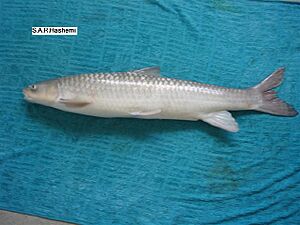Shabout facts for kids
Quick facts for kids Shabout |
|
|---|---|
 |
|
| A 55 cm (2 ft) shabout caught in Iran | |
| Conservation status | |
| Scientific classification | |
| Genus: |
Arabibarbus
|
| Species: |
grypus
|
| Synonyms | |
|
|
The shabout (scientific name: Arabibarbus grypus) is a type of cyprinid fish, which is a family that includes carps. People also call it shirbot, shabut, shabboot, or shabbout. This large freshwater fish lives in Western Asia. You can find it in the Tigris-Euphrates Basin and in rivers in Iran that flow into the Persian Gulf.
Shabout fish can grow quite big! They can reach up to 1.5 m (4.9 ft) long and weigh around 30 kg (66 lb). There are even stories of shabouts growing to 2 m (6.6 ft) and 100 kg (220 lb), but these might be confused with another large fish called the mangar. The shabout is important for fishing, but its numbers have gone down. This is mainly because of things like dams, taking too much water, dry weather, pollution, and overfishing.
Contents
Where Shabouts Live and What They Do
Shabouts live in rivers, from the small streams upstream to the wide river mouths. They are quite good at adapting to different places. You can also find them in calmer waters like marshes and reservoirs. However, they are strong swimmers and prefer water that flows slowly or at a medium speed. They also need a good amount of oxygen in the water.
Water Conditions and Migration
Adult shabouts like cooler water, ideally around c. 22 °C [72 °F]. In the summer, when the lower parts of rivers get warm, they migrate upstream to find cooler spots. Younger shabouts, however, tend to stay in the lower parts of the rivers all year. These fish can handle a wide range of temperatures. In the wild, they live in rivers that are between 10.2 and 32.8 °C (50–91 °F). Fish kept in aquaculture (fish farming) can live in water from 8 to 31 °C (46–88 °F).
Even though shabouts are freshwater fish, they can handle a little bit of salty water in estuaries (where rivers meet the sea). But if the water is too salty, they don't grow as well.
Reproduction and Diet
Shabouts lay their eggs in the spring and summer. They usually go to the upstream parts of rivers to breed. They look for places with cool, fast-flowing water that is not deeper than 1.5 m (4.9 ft) and has a gravel bottom. A female shabout is ready to lay eggs when she is at least three years old. She can lay a lot of eggs, sometimes up to 235,764! She places these eggs among gravel or plants.
The shabout mostly eats plants. Their diet includes many different plant materials, such as algae, larger water plants (called macrophytes), fruits, and even grains. They also eat smaller amounts of invertebrates (like insects or worms) and tiny fish. Some studies suggest that very large shabouts might eat more fish than smaller ones.
Shabouts and Fishing
The shabout is an important fish for people who fish for a living. For many years, too many shabouts have been caught in some areas, leading to overfishing. Also, dams block their paths when they try to migrate upstream to breed. Their homes are also harmed by water being taken out of rivers and by pollution. For example, in Iraq, the number of shabouts dropped by 90% between the 1960s and the 2000s. We don't have as much information for other places where they live.
People are also looking into farming shabouts, a process called aquaculture. Many other types of carp are already farmed to provide food for people.


